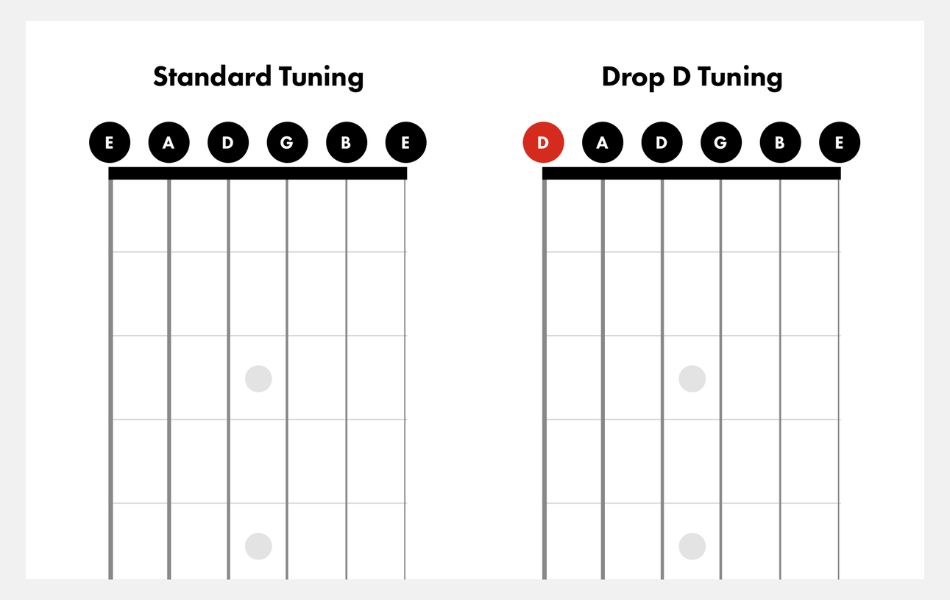Drop D Standard Tuning: Unveiling a New Sound"
Drop D standard tuning remains a widely embraced choice among guitarists, frequently heard resonating through rock and metal classics. Regardless of your expertise level, Drop D tuning can seamlessly find its place in your arsenal, offering a gateway to effortlessly execute power chords and achieve lower tones within songs. Whether you're a beginner or a seasoned player, Drop D tuning is a simple yet impactful technique that opens up new musical horizons.
What is drop D standard tuning?
Drop D standard tuning involves lowering the 6th string of the guitar from an E to a D note. In standard tuning, the strings are tuned from low to high as E, A, D, G, B, and E. However, in Drop D tuning, the strings are tuned as D, A, D, G, B, and E. While there are many ways to tune a guitar, Drop D stands out as a widely favored tuning due to its ease of tuning and manageable chord shapes.
The musical term that describes the departure of stringed instruments from their standard tunings is "Scordatura," originating from the Italian word for "mistuning." This applies not only to Drop D but also to all alternative tunings. These alternate tunings, including Drop D, unveil fresh combinations of notes and chord formations. In turn, grants musicians access to an array of new sounds and innovative playing techniques that wouldn't be achievable within the confines of standard tuning.

Musical style suit for drop D standard tuning
Drop D tuning is particularly well-suited for various musical styles, especially those that benefit from a heavier and more powerful sound.
Rock: Drop D tuning is commonly employed in rock music to achieve a meatier and more aggressive sound. It's favored by bands like Nirvana, Foo Fighters, and Soundgarden.
Hard Rock: Many hard rock bands utilize Drop D tuning to create a weightier and more impactful sound. Examples include bands like Three Days Grace and Breaking Benjamin.
Metal: Drop D is a staple tuning in metal genres, as it allows for easier execution of power chords and adds depth to riffs. Bands like Metallica and System of a Down use this tuning extensively.
Alternative Rock: This tuning can give alternative rock tracks a distinctive edge and contribute to the genre's signature sound. Bands like Tool and Chevelle often incorporate Drop D.
Nu-Metal: Nu-metal bands embrace Drop D for its ability to enhance the heavy and rhythmic elements of the genre. Groups like Korn and Limp Bizkit utilize this tuning to great effect.
Post-Grunge: Drop D is used in post-grunge music to achieve a blend of melodic and heavy elements. Bands like Staind and Seether are known for their use of this tuning.
Hardcore and Metalcore: These aggressive genres benefit from Drop D's added power and low-end resonance. Bands like Killswitch Engage and As I Lay Dying utilize it extensively.
Progressive Metal: Drop D can contribute to the complex and intricate soundscapes found in progressive metal. Bands like Dream Theater and Periphery incorporate it into their compositions.

Drawbacks of drop D standard tuning
Drop D tuning, while advantageous for certain styles, presents several challenges and limitations:
Chord Complexity
While Drop D is ideal for power chords, which align well with hard rock and heavy metal, it can complicate playing more intricate chords. Jazz musicians, who rely on richer harmony with four, five, or six distinct tones, might find Drop D less suitable for their needs.
Scales and Intuition
While no notes are lost in Drop D, it alters the interval pattern. The standard tuning follows a 4th interval pattern, whereas Drop D creates a 5th interval between the 6th and 5th strings. This can disrupt the intuitive patterns of certain scales.
Sound Variety
Drop D is heavy and rumbling sound isn't always ideal for every musical context. Guitarists seeking a brighter, treble-focused tone might find Drop D less accommodating. For example, Brian May of Queen used Drop D for "Fat Bottomed Girls". However, typically preferred standard tuning for his distinctive sound.
Transposition and Adaptation
When transitioning between Drop D standard tuning and standard tuning, or when playing with others in standard tuning, chords and scales must be transposed or adjusted. Potentially, it leads to confusion or challenges in live situations.
String Gauge and Setup
The lower tension in Drop D can affect string buzzing, playability, and string wear. Adjustments to the guitar's setup might be necessary.
Despite these limitations, Drop D remains a favored tuning for its specific benefits in certain musical styles. It's essential for guitarists to weigh these drawbacks against the advantages to determine if Drop D suits their musical preferences and needs.
Exploring drop D standard tuning might initially seem like venturing into uncharted waters, but it's a journey that holds the promise of fresh musical dimensions. As you delve into these tunings, you'll unearth novel approaches to crafting chords and tailoring the mood of your melodies, whether you're embracing a deeper resonance or basking in a lighter ambiance.






